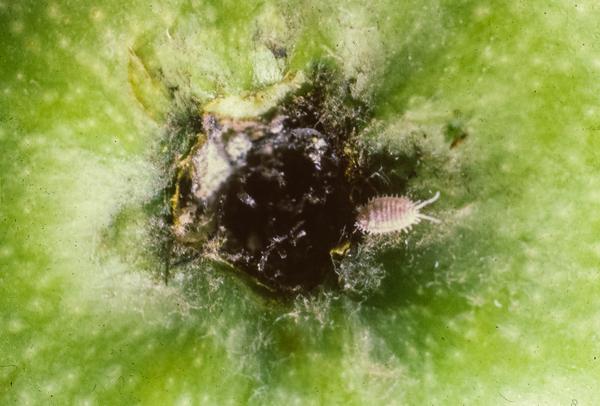Background and Description
Mealybugs are soft-bodied, segmented, elongate-oval insects that produce a waxy secretion that gives individuals a mealy or powdery appearance. Comstock mealybugs (Pseudococcus comstocki; CMB) are native to China and Japan but are now found throughout most of the world as pests of pome fruits. In eastern North America they are the most common mealybug pest, feeding on apple, pear, and peach as well as numerous ornamental plants (most notably catalpa and mulberry).
Adult female CMB are 3/32 to 3/16 inch (3 to 5mm) long, wingless, and have 17 pairs of filaments protruding from the periphery of the body, with the posterior pair being the longest. They have piercing-suckng mouthparts and, consequently, produce honeydew that serves as a substrate for the growth of sooty mold on fruit. Adult males are small and short-lived, and are thus unlikely to be encountered in the field. They have a gnat-like appearance totally unlike the females.
CMB larvae (crawlers) look like female adults except for being smaller with less wax and no long filaments. Eggs are tiny (around 1/100 inch (0.3mm) long), bright orange, elliptical, and laid in masses on twigs, pruning cuts, and the calyx ends of fruit (in the case of the summer generation) or in crevices of bark (during the autumn generation). These masses are referred to as ovisacs or nests and are usually covered in white waxy filaments that have a dense cottony appearance.
Life History
Eggs hatch in late spring, and nymphs feed on leaves and shoots until completing development around early July. These adults then lay eggs that hatch in about 11 days, and second generation larvae develop into adults by early fall. These adults lay overwintering eggs and in some cases overwinter themselves.
Damage
Damage to fruit is the result of CMB infesting the calyx, where they can produce large amounts of honeydew that serves as a substrate for the growth of sooty mold on the fruit exterior. The presence of CMB in the calyx is also a contamination problem on processed fruit.
Monitoring and Control
CMB populations can be monitored in the dormant season by removing loose bark and looking for eggs and crawlers and during the growing season by wrapping sticky tape on limbs and looking for crawlers. The calyx of fruit can also be checked at regular intervals.
CMB do not generally require any specific control methods, as they typically do not cause enough damage to be considered a major pest. Early season insecticide sprays are effective against eggs and crawling larvae. Once inside the calyx, adults are nearly impossible to remove.
See the "Pest and Orchard Management Program" section of the Integrated Orchard Management Guide for Commercial Apples in the Southeast for the most current control guidelines.
Publication date: Feb. 23, 2015
N.C. Cooperative Extension prohibits discrimination and harassment regardless of age, color, disability, family and marital status, gender identity, national origin, political beliefs, race, religion, sex (including pregnancy), sexual orientation and veteran status.




